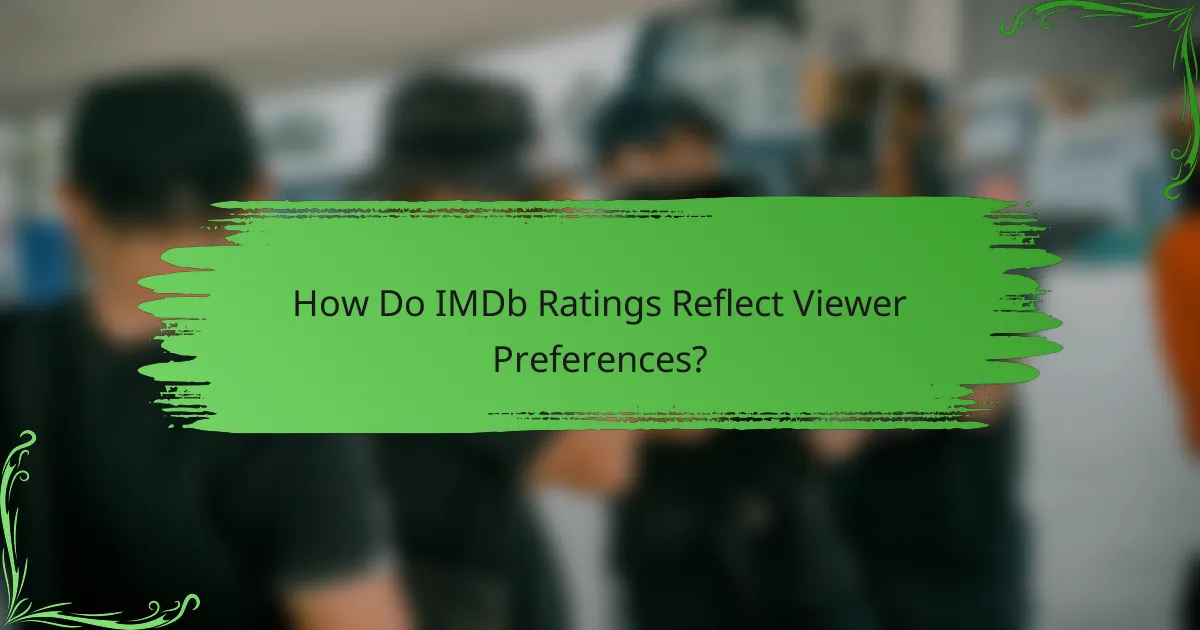Japanese films on IMDb are shaped by audience ratings and reviews, offering insights into viewer preferences and critical acclaim. These movies often present unique storytelling and cultural themes that resonate globally, while IMDb ratings serve as a valuable tool for potential viewers to assess the general reception of a film. Through exploring themes of identity, family, and the balance between tradition and modernity, these films provide a rich perspective on Japanese culture and society.

What Are the Most Popular Japanese Films on IMDb?
The most popular Japanese films on IMDb are determined by user ratings and reviews, reflecting audience preferences and critical acclaim. These films often showcase unique storytelling, cultural themes, and artistic styles that resonate with viewers worldwide.
Top-rated films
Top-rated Japanese films on IMDb typically include classics and modern masterpieces that have garnered high scores from audiences. Notable examples include “Spirited Away,” “Akira,” and “Seven Samurai,” which often receive ratings above 8.0. These films are celebrated for their innovative direction, compelling narratives, and rich character development.
When exploring top-rated films, consider checking IMDb for the latest ratings, as they can fluctuate with new reviews. Look for films that have won prestigious awards, as this often correlates with higher viewer ratings.
Box office successes
Box office successes in Japanese cinema often highlight films that not only received critical acclaim but also achieved significant commercial success. Titles like “Your Name” and “Demon Slayer: Mugen Train” have grossed hundreds of millions of dollars, making them some of the highest-grossing films in Japan’s history.
To identify box office hits, review earnings reports and industry analyses. These films typically appeal to a broad audience, combining popular genres with engaging storytelling, which can lead to repeat viewings and strong word-of-mouth recommendations.
Cult classics
Cult classics in Japanese cinema are films that have developed a dedicated fanbase over time, often characterized by unique themes or unconventional storytelling. Examples include “Battle Royale” and “Ringu,” which have influenced genres beyond Japan and gained international recognition.
These films may not always achieve mainstream success but resonate deeply with niche audiences. To discover cult classics, explore film forums and community recommendations, as these films often thrive on discussions and shared viewing experiences among fans.

How Do IMDb Ratings Reflect Viewer Preferences?
IMDb ratings provide a snapshot of viewer preferences by aggregating user scores for films. These ratings help potential viewers gauge the general reception of a movie, influencing their viewing choices based on collective opinions.
Rating distribution analysis
Rating distribution analysis examines how scores are spread across different ratings, typically from 1 to 10. A film with a high average rating but a significant number of low scores may indicate polarized opinions, while a consistent range of mid to high scores suggests broader appeal.
For example, if a Japanese film has a majority of ratings between 7 and 9, it likely resonates well with viewers. Conversely, a film with many 1 and 2 ratings alongside a few 10s may indicate a divisive reception.
Viewer demographics
Viewer demographics provide insights into who is rating the films, including age, gender, and geographic location. Understanding these demographics can reveal trends in preferences, such as younger audiences favoring anime films while older viewers may prefer classic dramas.
For instance, a Japanese film that receives high ratings from viewers aged 18-34 might indicate its appeal among younger audiences, potentially due to relatable themes or popular actors. Analyzing these demographics can help filmmakers and marketers tailor their content to specific audience segments.

What Are Common Themes in Japanese Films?
Japanese films often explore themes of identity, family, and the tension between tradition and modernity. These narratives reflect cultural values and societal issues, providing a window into the complexities of Japanese life.
Recurring motifs
Many Japanese films feature recurring motifs such as nature, isolation, and the supernatural. Nature often symbolizes the characters’ emotional states, while isolation reflects societal pressures and personal struggles. Supernatural elements frequently serve as metaphors for real-life challenges, allowing filmmakers to address complex topics in a more approachable manner.
For example, films like “Spirited Away” and “Ringu” utilize supernatural themes to explore human emotions and fears. These motifs resonate with audiences, offering deeper insights into the characters’ journeys.
Genre influences
Japanese cinema is heavily influenced by various genres, including anime, horror, and drama. Each genre brings unique storytelling techniques and thematic elements, enriching the overall cinematic landscape. Anime often blends fantasy with real-life issues, while horror films like “The Ring” delve into psychological fears and societal anxieties.
Additionally, the influence of traditional Japanese theater, such as Noh and Kabuki, can be seen in many films, particularly in their narrative structures and character development. This blend of genres and traditions creates a distinctive style that appeals to both domestic and international audiences.

How to Analyze IMDb Audience Reviews for Japanese Films?
Analyzing IMDb audience reviews for Japanese films involves examining the sentiments expressed by viewers and identifying key insights that can inform your understanding of the film’s reception. Focus on both the overall ratings and the qualitative feedback to gain a comprehensive view.
Review sentiment analysis
Review sentiment analysis involves categorizing audience feedback as positive, negative, or neutral. For Japanese films, this can reveal cultural preferences and common themes that resonate with viewers. Tools like natural language processing can help automate this analysis, but a manual review often uncovers nuanced insights.
When analyzing sentiment, consider the context of the reviews. For instance, a film that is critically acclaimed may receive mixed audience feedback due to cultural references that are not universally understood. Pay attention to recurring phrases or emotional expressions that indicate strong viewer reactions.
Key takeaways from reviews
Key takeaways from audience reviews can highlight what viewers appreciate or dislike about a film. Common themes in Japanese films include storytelling depth, character development, and visual aesthetics. These aspects often emerge as focal points in reviews, providing valuable insights into viewer preferences.
Additionally, look for trends in ratings over time. A film may initially receive low ratings but improve as more viewers watch and share their opinions. This can be indicative of word-of-mouth influence or changing perceptions as the film gains popularity. Regularly checking updates on IMDb can help track these shifts.

What Are Viewer Insights on Japanese Films?
Viewer insights on Japanese films encompass audience ratings, reviews, and engagement metrics that reflect how films resonate with viewers. These insights can guide potential viewers in selecting films and help filmmakers understand audience preferences.
Viewer engagement metrics
Viewer engagement metrics for Japanese films include ratings on platforms like IMDb, where audiences can score films on a scale from 1 to 10. Typically, popular films may achieve ratings in the range of 7 to 9, indicating strong viewer approval. Additionally, metrics such as the number of reviews and comments can provide insight into how actively viewers are discussing and engaging with a film.
Another important metric is the viewing duration, which can reveal how captivating a film is. Films that maintain viewer attention for longer periods often indicate a higher level of engagement. Tracking these metrics over time can help identify trends in viewer preferences.
Trends in viewer feedback
Trends in viewer feedback for Japanese films often highlight cultural themes, storytelling techniques, and character development that resonate with audiences. Many viewers appreciate films that incorporate traditional Japanese elements, such as folklore or historical contexts, while others may favor contemporary narratives that address modern societal issues.
Common feedback patterns show that viewers frequently comment on the emotional depth and visual artistry of Japanese films. Positive reviews often emphasize the unique cinematography and sound design that enhance the storytelling experience. Conversely, critiques may focus on pacing or character development, suggesting areas for filmmakers to improve.

How Do Japanese Films Compare to Other International Cinema?
Japanese films often stand out in international cinema due to their unique storytelling, cultural themes, and artistic styles. While they may not always achieve the same box office success as Hollywood productions, they frequently receive high acclaim for their creativity and emotional depth.
Comparative ratings
When comparing ratings, Japanese films generally receive favorable scores on platforms like IMDb, often ranging from the mid-seventies to the low nineties. This is particularly true for critically acclaimed works by directors such as Hayao Miyazaki or Akira Kurosawa, which frequently garner ratings above 8.0.
In contrast, mainstream international films, especially from Hollywood, often dominate box office numbers but may not always achieve the same level of critical acclaim. For instance, while a blockbuster might earn high viewer ratings, it may lack the nuanced storytelling found in many Japanese films.
Viewer preferences across cultures
Viewer preferences can vary significantly between cultures, influencing how Japanese films are received globally. Audiences in Japan often appreciate subtlety and character development, while Western viewers may favor faster-paced narratives and action-driven plots.
Moreover, cultural references in Japanese cinema can sometimes pose challenges for international audiences. Understanding these nuances can enhance appreciation; for example, familiarity with Japanese customs or folklore can deepen the viewing experience. Subtitled versions are often recommended to capture the original dialogue’s emotional weight.

What Are the Emerging Trends in Japanese Cinema?
Emerging trends in Japanese cinema reflect a blend of traditional storytelling and modern influences, showcasing innovative techniques and the impact of digital platforms. Filmmakers are increasingly exploring diverse narratives and genres, adapting to changing viewer preferences and technological advancements.
Innovative storytelling techniques
Japanese filmmakers are pushing boundaries with unique storytelling methods, often incorporating non-linear narratives and surreal elements. This approach allows for deeper emotional engagement and invites viewers to interpret the story in varied ways.
For instance, films like “Your Name” and “Spirited Away” utilize dreamlike sequences and complex character arcs, captivating audiences both domestically and internationally. Such techniques not only enhance the visual experience but also challenge conventional storytelling norms.
Influence of streaming platforms
The rise of streaming platforms has significantly transformed how Japanese films reach audiences. Services like Netflix and Amazon Prime Video are investing in local content, providing filmmakers with broader distribution channels and increased budgets for production.
This shift has led to a surge in original Japanese films and series, catering to global audiences while maintaining cultural authenticity. As a result, viewers can access a wider variety of genres, from horror to romance, often with subtitles or dubbing available in multiple languages.
